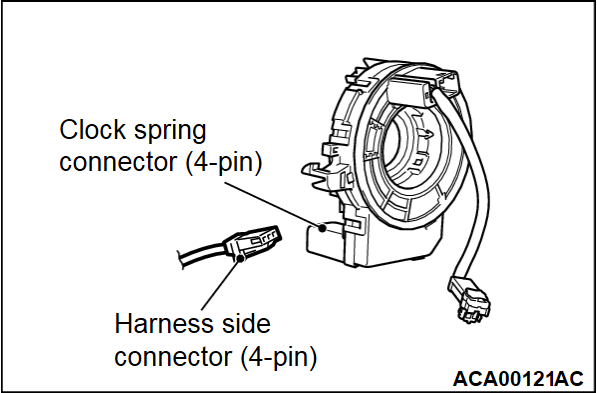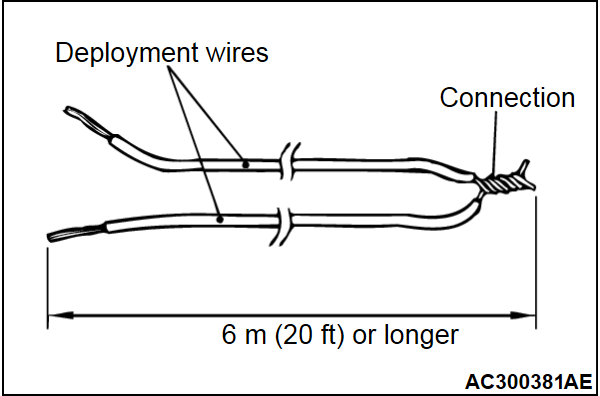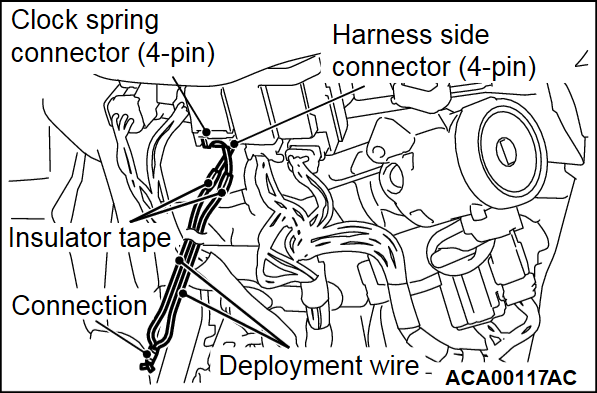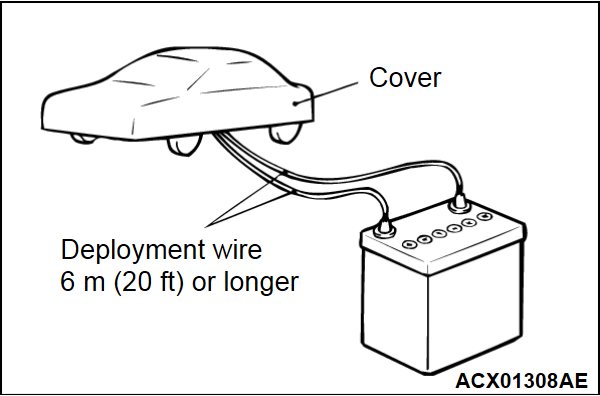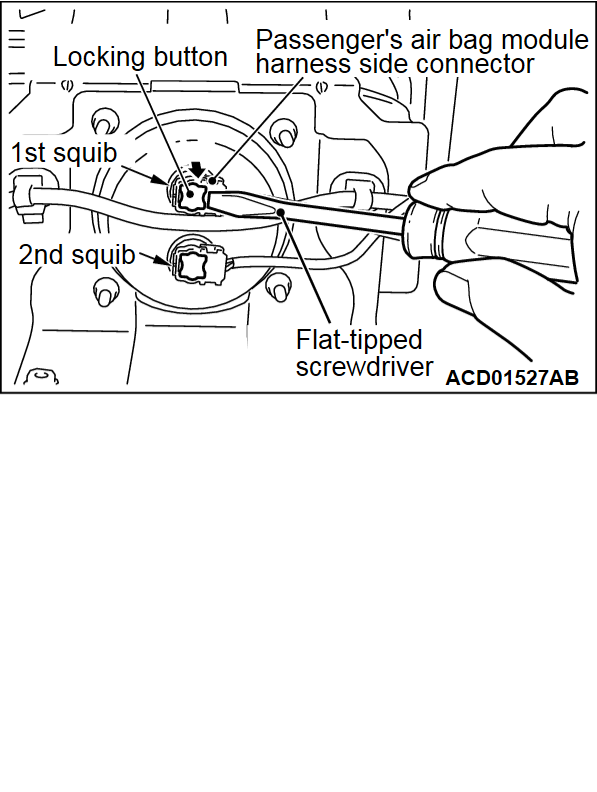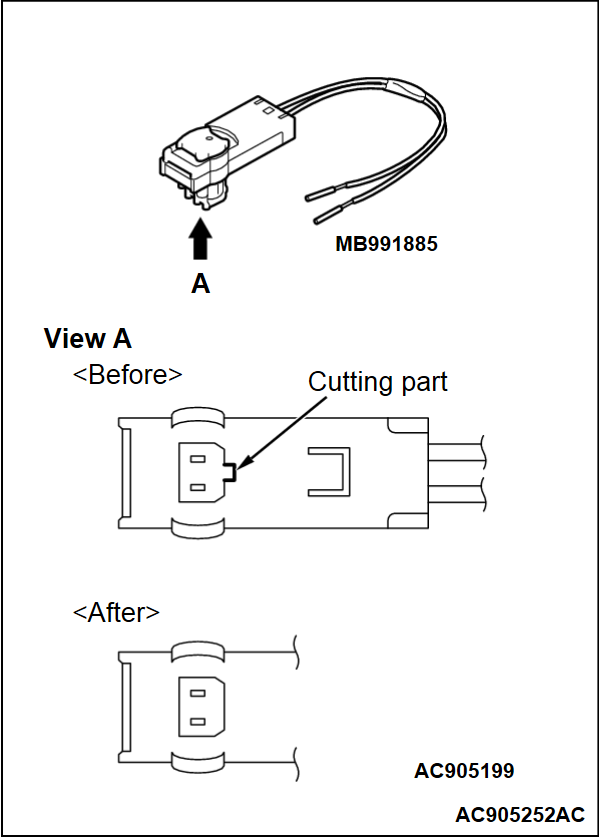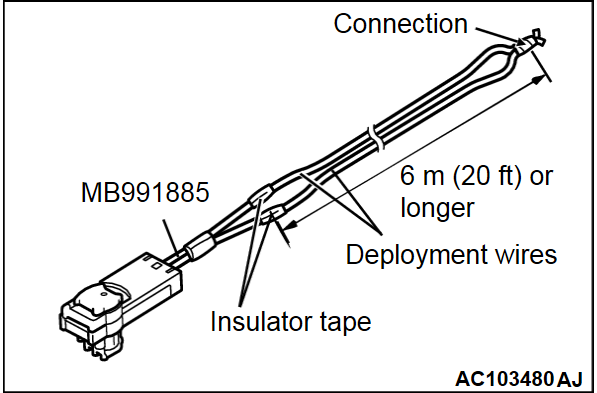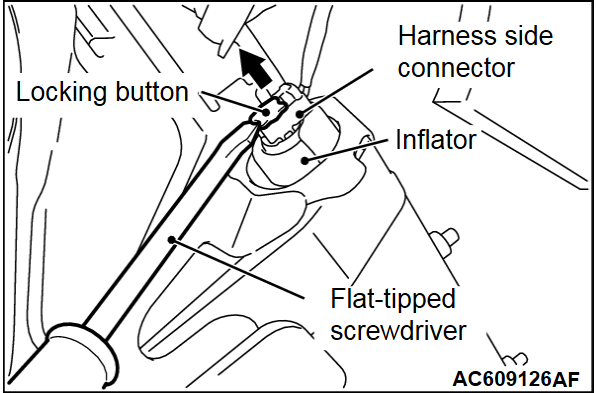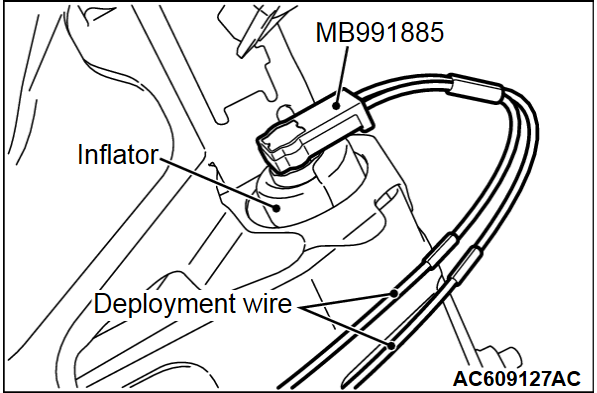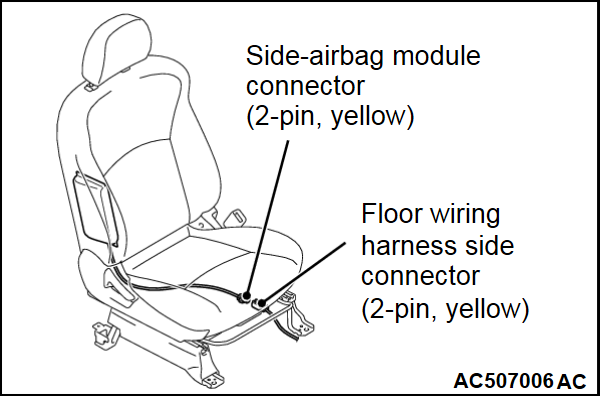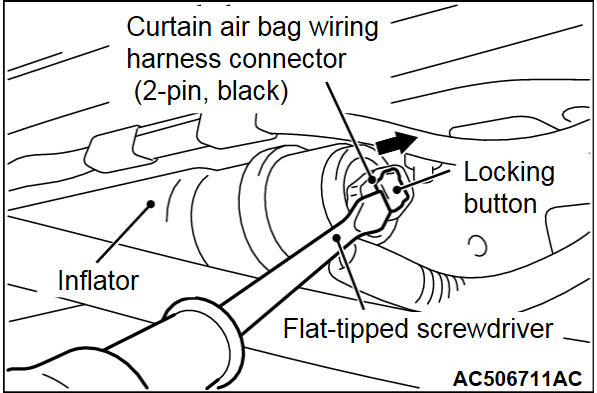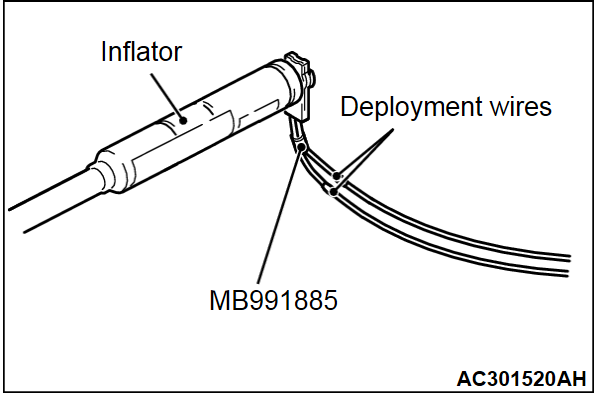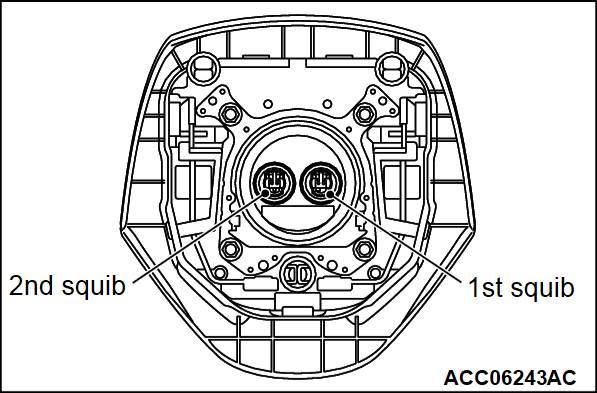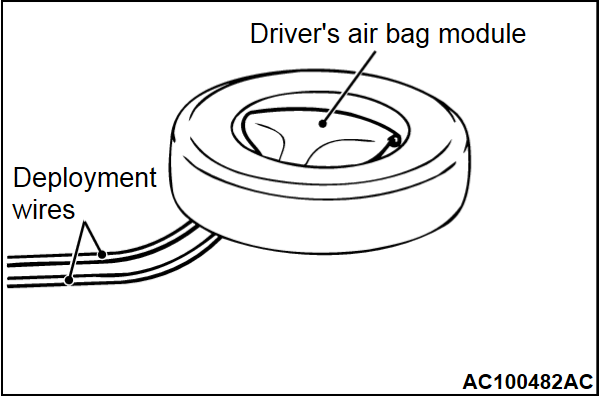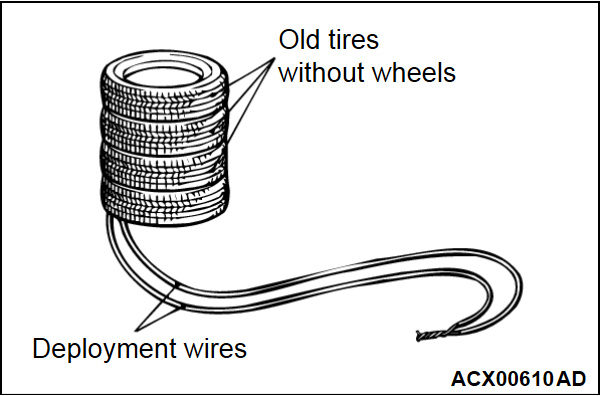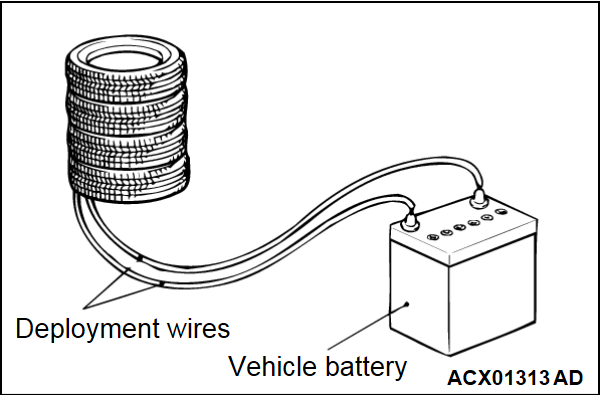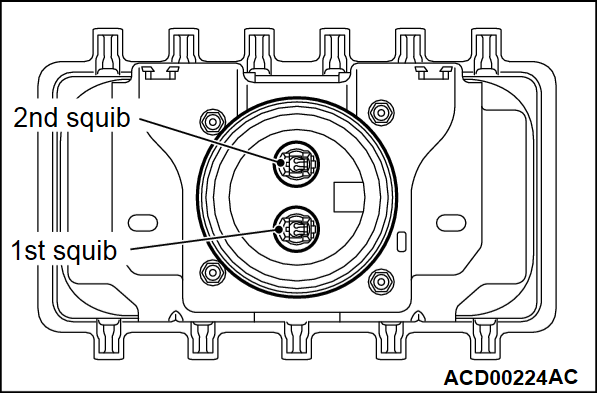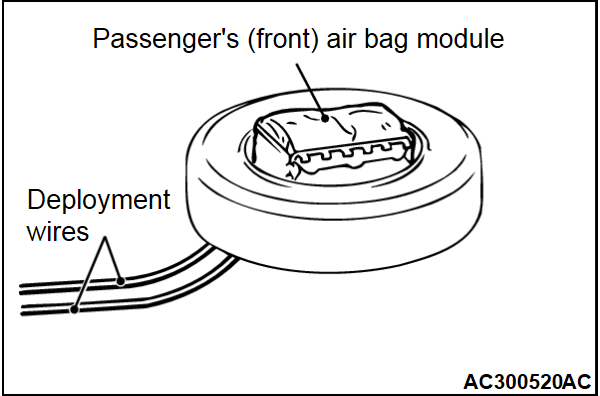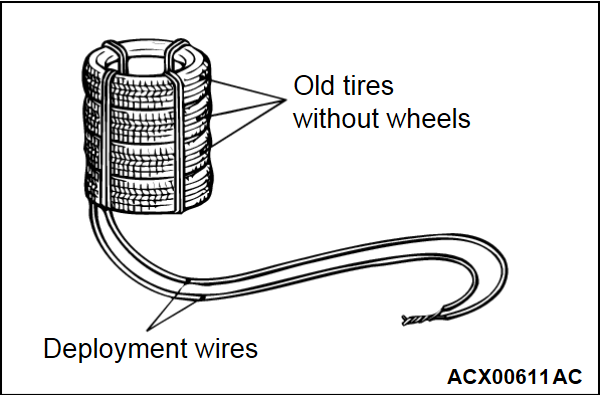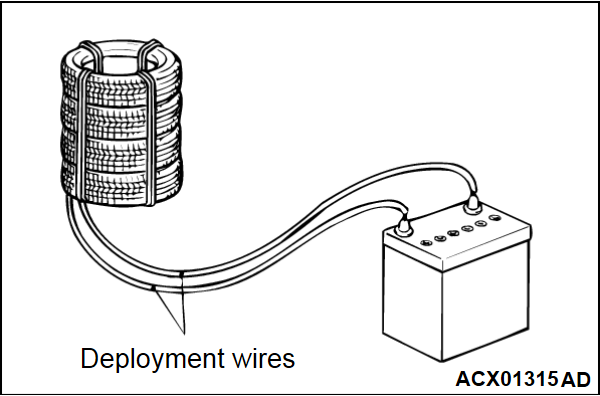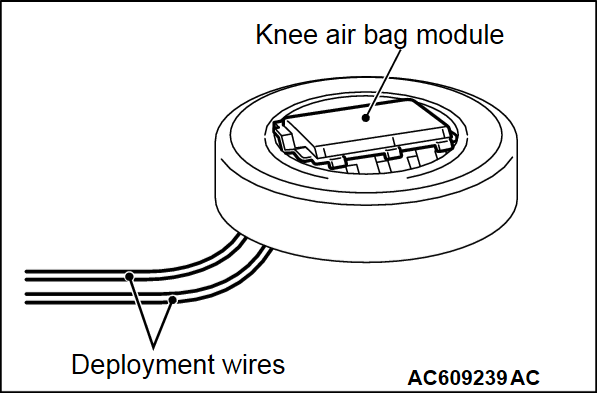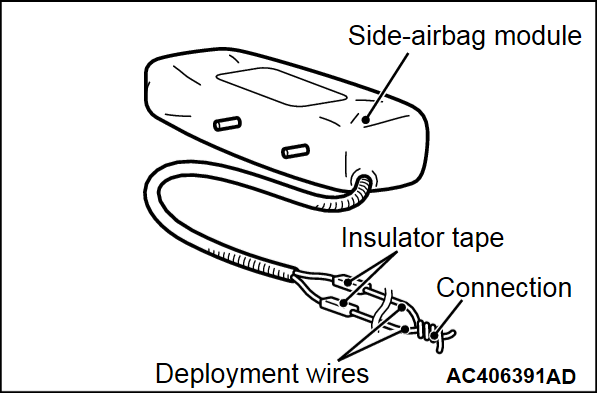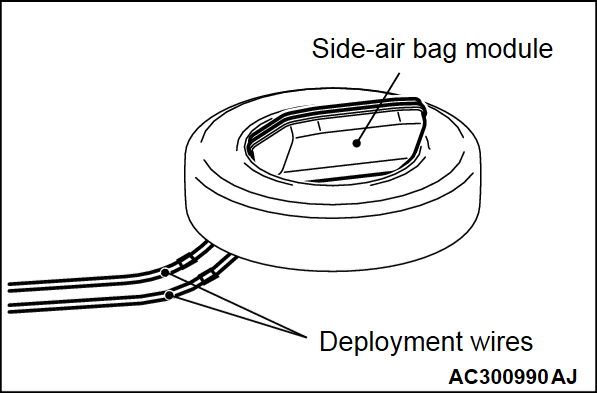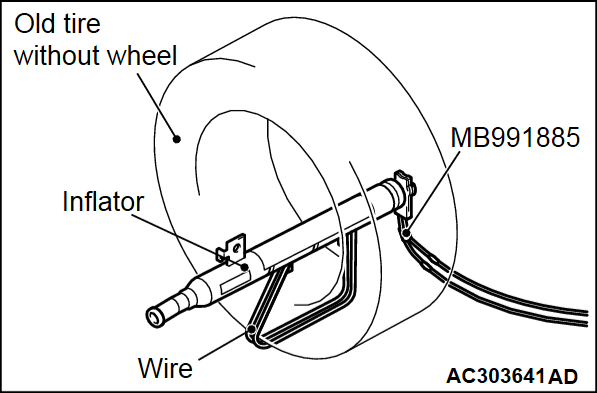AIR BAG MODULE DISPOSAL PROCEDURES
When discarding the air bag modules or a vehicle with SRS air bags, be sure to deploy the air bags in advance as specified in the service procedure that follows.
DISPOSAL OF UNDEPLOYED AIR BAG MODULES
| caution |
|
DRIVER'S AIR BAG MODULE DEPLOYMENT INSIDE THE VEHICLE
1. Move the vehicle to flat and isolated spot.
2.
| caution | Disconnect the battery cable connection, and wait for 60 seconds or more before starting the work. |
Disconnect the (-) and (+) terminals of battery cable, and then remove the battery from the vehicle.
4. Remove the connection between the clock spring connector (4-pin) and the harness side connector (4-pin).
| note | Once disconnected from the instrument panel wiring harness, both electrodes of the clock spring connector short automatically. This prevents the driver's air bag from accidental deployment caused by static, etc. |
5. Obtain two suitable wires, which are 6 m (20 feet) or longer, as deployment wires. Then connect the wires at one end to short.
6. Touch the vehicle's body with bare hands to discharge static in you.
7. Use nippers to cut the wires (white and black-white) at the wiring harness side connector (4-pin). Connect the deployment wires to the two cut wiring harness wires, and then wrap a insulation tape around the connections. Then pull out the deployment wires through the door window.
| note | The disconnection location should be sufficiently away from the harness side connector with consideration to the expansion harness connection location upon disconnections. |
8. Connect the harness side connector connected with an expansion harness to the clock spring connector.
9.
| warning | If the glass is scratched, the glass may be shattered at deployment. Therefore, cover with a vehicle cover to avoid danger. |
In order to suppress the operation sound as much as possible, fully close all the door windows, close the doors, and then cover the vehicle with a vehicle cover.
10.
| caution |
|
Disconnect the deployment wire connection at a place as far as possible from the vehicle. Then, connect the wires to the removed vehicle battery to deploy the air bag module.
PASSENGER'S (FRONT) AIR BAG MODULE DEPLOYMENT INSIDE THE VEHICLE
| caution | Two connectors are installed to allow the passenger's air bag module to deploy in two stages. To ignite the 1st and 2nd squibs one after another, observe the following procedure: |
1. Move the vehicle to flat and isolated spot.
| caution | Disconnect the battery cable connection, and wait for 60 seconds or more before starting the work. |
2. Disconnect the (-) and (+) terminals of battery cable, and then remove the battery from the vehicle.
3. Disconnect the passenger's (front) air bag module harness side connector (1st squib side). (Refer to  ).
).
 ).
).4. Use the flat-tipped screwdriver to pull out the locking button of passenger's (front) air bag module harness side connector (1st squib side). After releasing the lock, disconnect the connector.
| note | When the passenger's (front) air bag module harness side connector is disconnected from the inflator, the two pins of inflator connector are automatically shorted. This prevents the unintentional deployment of passenger's (front) air bags caused by the static or others. |
5. Cut the part shown to connect the adapter harness (Special tool: MB991885) to the driver's airbag module connector (only when deploying the 2nd squib).
| note | This is because the 2nd squib connector is different in shape. |
6. Connect the deployment wires of 6 m (20 feet) or more to each of the two wiring harnesses of special tool adapter harness (MB991885), and cover the connection areas with insulation tape. Keep the other ends of deployment wires connected to each other (shorted).
| note | This prevents the unintentional activation of inflator caused by the static or others. |
7. Connect the adapter harness to the passenger's (front) air bag module (1st squib side), and then pull out the deployment wire to outside the vehicle.
8.
| warning | If the glass is scratched, the glass may be shattered at deployment. Therefore, cover with a vehicle cover to avoid danger. |
In order to suppress the operation sound as much as possible, fully close all the door windows, close the doors, and then cover the vehicle with a vehicle cover.
9.
| caution |
|
Disconnect the deployment wire connection at a place as far as possible from the vehicle. Then, connect the wires to the removed vehicle battery to deploy the air bag module.
10. Deploy the 2nd squib according to steps 3 to 10.
KNEE AIR BAG MODULE DEPLOYMENT INSIDE THE VEHICLE
1. Move the vehicle to flat and isolated spot.
| caution | Disconnect the battery cable connection, and wait for 60 seconds or more before starting the work. |
2. Disconnect the (-) and (+) terminals of battery cable, and then remove the battery from the vehicle.
4. Use the flat-tipped screwdriver to pull out the locking button of harness side connector. After releasing the lock, disconnect the connector.
| note | When the harness side connector is disconnected from the inflator, the two pins of inflator connector are automatically shorted. This prevents the unintentional deployment of knee air bag caused by the static or others. |
5. Connect the deployment wires of 6 m (20 feet) or more to each of the two wiring harnesses of special tool adapter harness (MB661885), and cover the connection areas with insulation tape. Keep the other ends of deployment wires connected to each other (shorted).
| note | This prevents the unintentional deployment of knee air bag caused by the static or others. |
6. Connect the adapter harness to the inflator, and then pull out the deployment wire to outside the vehicle.
7.
| warning | If the glass is scratched, the glass may be shattered at deployment. Therefore, cover with a vehicle cover to avoid danger. |
In order to suppress the operation sound as much as possible, fully close all the door windows, close the doors, and then cover the vehicle with a vehicle cover.
8.
| caution |
|
Disconnect the deployment wire connection at a place as far as possible from the vehicle. Then, connect the wires to the removed vehicle battery to deploy the air bag module.
SIDE-AIRBAG MODULE DEPLOYMENT INSIDE THE VEHICLE
1. Move the vehicle to flat and isolated spot.
| caution | Disconnect the battery cable connection, and wait for 60 seconds or more before starting the work. |
2. Disconnect the (-) and (+) terminals of battery cable, and then remove the battery from the vehicle.
3. Disconnect the connections of the side-airbag module connector (2-pin: yellow) and the floor harness connector (2-pin: yellow).
| caution | Make sure to deploy both driver's and front passenger's side-airbags. |
| note | When the side-airbag module connector is disconnected from the floor harness, the two pins of side-airbag module connector are automatically shorted. This prevents the unintentional deployment of side-airbags caused by the static or others. |
4. Prepare two deployment wires of 6 m (20 feet) or more, and keep the terminal at one end connected to that of the other wire (shorted).
| note | This prevents the air bags from unintentional deployment caused by static. |
5.
| caution | The following procedures are intended to prevent the unintentional deployment caused by the static. Therefore, make sure to perform the procedures. |
Touch the vehicle body with bare hands to release the charged static.
6. With the side-airbag module connector disconnected, cut the floor harness using nippers or similar tools.
7. Connect the deployment wire to each of two cut wiring harnesses. After covering the connection areas with insulation tape, pull out the deployment wire to outside the vehicle.
8. Connect the floor harness, to which the deployment wire is connected, to the side-airbag module connector.
9.
| warning | If the glass is scratched, the glass may be shattered at deployment. Therefore, cover with a vehicle cover to avoid danger. |
In order to suppress the operation sound as much as possible, fully close all the door windows, close the doors, and then cover the vehicle with a vehicle cover.
10.
| caution |
|
Disconnect the deployment wire connection at a place as far as possible from the vehicle. Then, connect the wires to the removed vehicle battery to deploy the side-airbag module.
CURTAIN AIR BAG MODULE DEPLOYMENT INSIDE THE VEHICLE
1. Move the vehicle to flat and isolated spot.
| caution | Disconnect the battery cable connection, and wait for 60 seconds or more before starting the work. |
2. Disconnect the (-) and (+) terminals of battery cable, and then remove the battery from the vehicle.
4. Use the flat-tipped screwdriver to pull out the locking button of curtain air bag harness connector. After releasing the lock, disconnect the connector.
| note | When the curtain air bag module connector is disconnected from the inflator, the two pins of inflator connector are automatically shorted. This prevents the unintentional deployment of curtain air bags caused by the static or others. |
5. Connect the deployment wires of 6 m (20 feet) or more to each of the two wiring harnesses of special tool adapter harness (MB661885), and cover the connection areas with insulation tape. Keep the other ends of deployment wires connected to each other (shorted).
| note | This prevents the unintentional deployment of curtain air bags caused by the static or others. |
6. Connect the adapter harness to the inflator, and then pull out the deployment wire to outside the vehicle.
7.
| warning | If the glass is scratched, the glass may be shattered at deployment. Therefore, cover with a vehicle cover to avoid danger. |
In order to suppress the operation sound as much as possible, fully close all the door windows, close the doors, and then cover the vehicle with a vehicle cover.
8.
| caution |
|
Disconnect the deployment wire connection at a place as far as possible from the vehicle. Then, connect the wires to the removed vehicle battery to deploy the air bag module.
DRIVER'S AIR BAG MODULE DEPLOYMENT OUTSIDE THE VEHICLE
| caution |
|
1.
| caution | Disconnect the battery cable connection, and wait for 60 seconds or more before starting the work. |
Disconnect the (-) and (+) terminals of battery cable, and then remove the battery from the vehicle.
2.
| caution | When the connector is disconnected, the two pins of air bag module are automatically shorted to prevent the unintentional deployment caused by the static or others. However, in preparation for the accidental deployment, store the air bag module on a flat place with the deployment surface facing upward. Also, do not put anything on it. |
3. Connect the deployment wires of 6 m (20 feet) or more to each of the two wiring harnesses of special tool adapter harness (MB991885), and cover the connection areas with insulation tape. Keep the other ends of deployment wires connected to each other (shorted).
| note | This prevents the unintentional activation of inflator caused by the static or others. |
4. Connect the adapter harness to the driver's air bag module (2nd squib side).
5. To the torx screw installation hole located at the backside of air bag module, tie a thick wire for fixing the wheel.
6. Pass the deployment wire connected to the air bag module underneath the old tire with wheel. Then, fix the air bag module with deployment surface facing upward using the wire which is tied to the bolt.
7. Place three old tires without wheel onto the tire to which the air bag module is fixed.
8.
| caution |
|
Disconnect the deployment wire connection at a place as far as possible from the air bag module. Then, connect the wires to the removed vehicle battery to deploy the air bag module.
PASSENGER'S (FRONT) AIR BAG MODULE DEPLOYMENT OUTSIDE THE VEHICLE
| caution |
|
1.
| caution | Before starting the work, wait for 60 seconds or more after the disconnection of the battery cable. (Refer to the item 5  of Service Precautions.) of Service Precautions.) |
Disconnect the (-) and (+) terminals of battery cable, and then remove the battery from the vehicle.
2.
| caution | When the connector is disconnected, the two pins of air bag module are automatically shorted to prevent the unintentional deployment caused by the static or others. However, in preparation for the accidental deployment, store the air bag module on a flat place with the deployment surface facing upward. Also, do not put anything on it. |
3. Cut the part shown to connect the adapter harness (Special tool: MB991885) to the driver's airbag module connector (only when deploying the 2nd squib).
| note | This is because the 2nd squib connector is different in shape. |
4. Connect the deployment wires of 6 m (20 feet) or more to each of the two wiring harnesses of special tool adapter harness (MB991885), and cover the connection areas with insulation tape. Keep the other ends of deployment wires connected to each other (shorted).
| note | This prevents the unintentional activation of inflator caused by the static or others. |
5. Connect the adapter harness to the passenger's (front) air bag module (1st squib side).
6. Pass a thick wire through the hole of air bag module bracket. Then, with the air bag module deployment surface facing upward, fix the module to the old tire with wheel.
7. Place three old tires without wheel onto the tire to which the air bag module is fixed. Then, tie and fix all the tires with rope (4 positions).
| note | The passenger's (front) air bag has a larger deployment volume than the driver's air bag. Therefore, it is necessary to tie the tires with rope. |
8.
Disconnect the deployment wire connection at a place as far as possible from the air bag module. Then, connect the wires to the removed vehicle battery to deploy the air bag module.
| caution |
|
9. Deploy the 2nd squib according to steps 2 to 8.
KNEE AIR BAG DEPLOYMENT OUTSIDE THE VEHICLE
| caution |
|
1.
| caution | Disconnect the battery cable connection, and wait for 60 seconds or more before starting the work. |
Disconnect the (-) and (+) terminals of battery cable, and then remove the battery from the vehicle.
2.
| caution | When the connector is disconnected, the two pins of air bag module are automatically shorted to prevent the unintentional deployment caused by the static or others. However, in preparation for the accidental deployment, store the air bag module on a flat place with the deployment surface facing upward. Also, do not put anything on it. |
3. Connect the deployment wires of 6 m (20 feet) or more to each of the two wiring harnesses of special tool adapter harness (MB991885), and cover the connection areas with insulation tape. Keep the other ends of deployment wires connected to each other (shorted).
| note | This prevents the unintentional activation of inflator caused by the static or others. |
4. Connect the adapter harness to the knee air bag module.
5. Pass the thick wire through the hole of air bag module mounting bracket. When, with the air bag module deployment surface facing upward, fit the module to the old tire with wheel.
6. Place three old tires without wheel onto the tire to which the air bag module is fixed.
7.
| caution |
|
Disconnect the deployment wire connection at a place as far as possible from the air bag module. Then, connect the wires to the removed vehicle battery to deploy the air bag module.
SIDE-AIRBAG MODULE DEPLOYMENT OUTSIDE THE VEHICLE
| caution |
|
1.
| caution | Before starting the work, wait for 60 seconds or more after the disconnection of the battery cable. (Refer to the item 5  of Service Precautions.) of Service Precautions.) |
Disconnect the (-) and (+) terminals of battery cable, and then remove the battery from the vehicle.
2. Remove the front seat assembly incorporated in side-airbag from the vehicle (GROUP 52A - Front Seat Assembly  ).
).
 ).
).3.
| caution | When the connector is disconnected, the two pins of side-airbag module are automatically shorted to prevent the unintentional deployment caused by the static or others. However, in preparation for the accidental deployment, store the air bag module on a flat place with the deployment surface facing upward. Also, do not put anything on it. |
4. Prepare two deployment wires of 6 m (20 feet) or more, and keep the terminal at one end connected to that of the other wire (shorted).
| note | This prevents the air bags from unintentional deployment caused by static. |
5.
| caution | The following procedures are intended to prevent the unintentional deployment caused by the static. Therefore, make sure to perform the procedures. |
Touch the vehicle body with bare hands to release the charged static.
6. Cut off the side-airbag module wiring harness connector from the wiring harness with nippers. Connect the deployment wire to each of the two cut wiring harnesses, and cover the connection areas with insulation tape.
7. Pass the deployment wire under the tire with wheel, and connect it to the side-airbag module connector.
8. Install a surplus nut to the side-airbag module bolt. Then, tie a thick wire for fixing the wheel to the bolt. Fix the side-airbag module to the wheel of old tire with the module deployment surface facing upward.
9. Place three old tires without wheel onto the tire to which the side-airbag module is fixed. Then, tie and fix all the tires with rope. (4 positions)
10.
Disconnect the deployment wire connection at a place as far as possible from the air bag module. Then, connect the wires to the removed vehicle battery to deploy the air bag module.
| caution |
|
CURTAIN AIR BAG INFLATOR ACTIVATION OUTSIDE THE VEHICLE
| caution |
|
1.
| caution | Before starting the work, wait for 60 seconds or more after the disconnection of the battery cable. (Refer to the item 5  of Service Precautions.) of Service Precautions.) |
Disconnect the (-) and (+) terminals of battery cable, and then remove the battery from the vehicle.
2.
| caution | When the connector is disconnected, the two pins of inflator are automatically shorted to prevent the unintentional activation caused by the static or others. However, in preparation for the accidental activation, store the air bag module on a flat place with the activation surface facing upward. Also, do not put anything on it. |
3. Use the flat-tipped screwdriver to pull out the locking button of curtain air bag harness connector. After releasing the lock, disconnect the connector.
| note | When the harness connector is disconnected from the inflator, the two pins of inflator connector are automatically shorted. This prevents the unintentional activation of inflator caused by the static or others. |
4. Cut the inflator from the air bag as shown in the figure using a cutter or a similar tool.
5. Connect the deployment wires of 6 m (20 feet) or more to each of the two wiring harnesses of special tool adapter harness (MB991885), and cover the connection areas with insulation tape. Keep the other ends of deployment wires connected to each other (shorted).
| note | This prevents the unintentional activation of inflator caused by the static or others. |
6. Feed a thick wire through the bracket of the inflator, and connect it to an old tire with a wheel.
7. Connect the adapter harness to the inflator connector.
8. Place the tire to which the inflator is fixed onto the two stacked tires. Then, place 1 or more old tires without wheel onto the stacked tires, and tie and fix all the tires with rope. (4 positions)
9.
Disconnect the deployment wire connection at a place as far as possible from the inflator. Then, connect the wires to the removed vehicle battery to activate the inflator.
| caution |
|
DISCARD OF DEPLOYED AIR BAG MODULE
After deployment and operation, the air bag module and seat belt pre-tensioner should be disposed of in the same manner as any other scrap parts, adhering to local laws and/or legislation. Observe the following precautions during air bag or seat belt pre-tensioner disposal:
1. Immediately after the air bag deployment, the inflator is extremely hot. Thus, before handling, leave the inflator for 30 minutes or more to cool.
2. Do not pour water or oil onto the deployed air bag module.
3. To the deployed air bag module, substances that irritate eyes and skin may be deposited. Therefore, wear gloves and protective glasses when handling the module. When the substance comes in contact with eyes or skin, flush with a large amount of water.
4. Place the air bag module in the sturdy plastic bag, and seal the bag for disposal.
5. After the work, be sure to wash your hands with water.
![[Previous]](../../../buttons/fprev.png)
![[Next]](../../../buttons/fnext.png)
